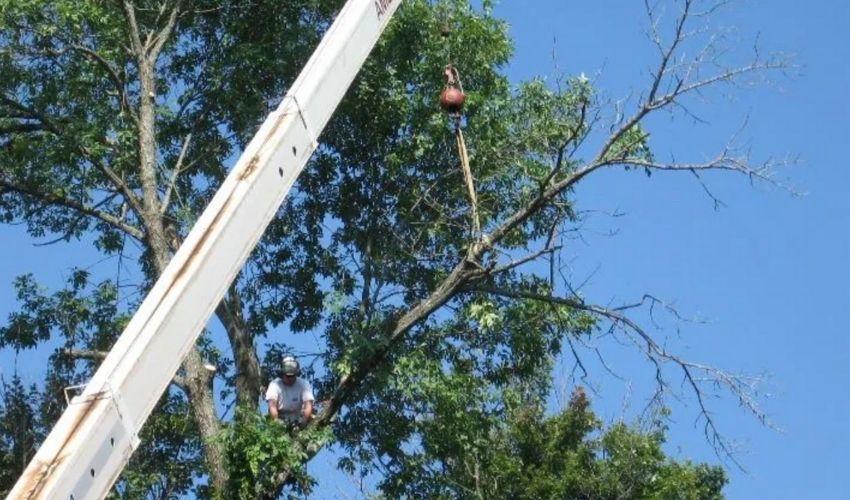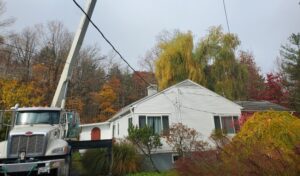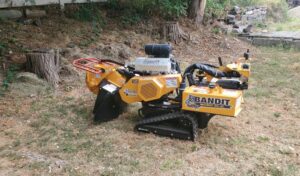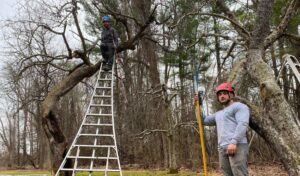
If you’re wondering what is the best time to prune your trees or shrubs, you’re not alone. We’re often asked “What’s the best time of year for tree trimming?” but the answer isn’t always a simple one.
Keep reading for the pros and cons of pruning trees in each season, as well as the reasons why you might want to tree your trees in spring, summer, fall, or winter.
Pruning Trees in Winter
Winter (the “dormant season”) is the preferred time for pruning most shade and ornamental trees. Dormancy refers to the time after the leaves have fallen in autumn, and before the new leaves emerge in the spring.
Benefits of Winter Pruning
There are many benefits provided by performing pruning operations during this period. Foremost, work is completed with less disruption at a time when the yard is less intensely used and the ground is firm. Work can proceed more efficiently—saving both time and money.
Not only does winter tree pruning make good ¢ent$, but it’s also good for the trees themselves.
This is especially true for fruit trees. We recommend most orchard pruning take place in late winter before bud break.
Trees respond to dormant pruning with a consistent growth response. Pruning wounds often close faster when made in the winter than those made in the summer. Also, there is less disease and insect presence because they are also inactive during this time. And because the foliage isn’t in the way, pruning during the dormant season allows our arborists to more quickly evaluate the structure of the tree and identify any needed modification. Efficiency is also increased because the limbs weigh less and are more easily handled without the substantial weight of the foliage.
Dormant pruning will remove the flower buds on early spring-blooming plants. If you want to see the tree or shrub bloom in early spring, it’s best to delay pruning until just after it’s finished flowering.
Pruning Trees in Spring
While winter is a great time to prune, that doesn’t mean that pruning during spring and summer isn’t good for your trees. It simply offers different benefits and is done for different reasons.
Reasons to Trim Trees in Spring
Spring-time tree trimming is often done during the growing season to deal with any issues that weren’t obvious until the trees leafed out. Here are some good reasons to prune trees in spring.
- Removing deadwood that isn’t easy to identify in winter – While arborists can usually identify deadwood, on some tree species it’s more difficult to tell if a branch is dead when the tree is dormant.
- Removing damaged or diseased branches – Branches damaged during winter or injured by frost can pose a safety hazard or compromise the tree’s health.
- Improving the overall look of the tree – Once a tree has leafed out, the weight of leaves can change the tree’s shape.
- Opening up the tree – This will increase air circulation (to help prevent fungal problems) and allow more sunlight into the interior of the tree.
- Raising the canopy – Removing lower branches can improve your view and access around the tree.
- Reducing tree size – This is a good time to prune shrubs and trees that have grown too large or are getting in the way.
- Trim summer- and fall-flowering shrubs and ornamental trees before they start leafing out
You can remove any dead or damaged branches whenever you see them, but you’ll be more easily able to tell what’s dead after the branches have leafed out.
Pruning Trees in Summer
Winter pruning is done to keep a tree’s branch structure, height, and crown size in balance. But vigorous tree growth in spring can easily overtake and unbalance a tree that was carefully shaped in winter. Depending on the age, species, and vigor of your trees, you may find that what was a tidy springtime tree has become an overgrown summer tree.
If your trees look dense, uneven, or just plain huge, summer pruning can be done to open their canopy and improve their shape.
You can think of summer tree pruning as the final step of your annual tree care cycle. It’s done when winter’s structural pruning has filled in after spring’s fertilizing and mulching has generated new growth, and before fall’s brilliant color display and leaf drop.
Reasons to Prune Trees in Summer
Summer tree pruning differs from winter pruning in several important ways. Rather than doing major structural work, summer pruning is good for:
- Opening up a tree’s crown to more sunlight
- Refining the shape of a tree but not changing its structure
- Removing rapid spring growth that’s making the tree too large or unbalanced
- Removing damaged or diseased branches
- Keeping tree canopies away from buildings and utility lines
Benefits of Summer Pruning
Sappy trees, like maple and birch, have much less sap flowing through their branches in summer, so your pruning cuts won’t weep sap as they would in late winter or early spring.
Fruit trees also benefit from summer pruning by slowing down leafy growth and giving a boost to fruit growth. Just use a lighter touch when cutting back branches in summer; save the major structural work on fruit trees for late winter.
Overly long branches and branches weighed down with exuberant foliage are more likely to break during summer storms, which may result in structural damage that requires corrective pruning.
To avoid this costly and stressful (for you and for your tree!) work, have your trees regularly inspected and pruned. Some preventive care can ensure your trees have a long life and a natural-looking form.
When NOT to Trim Trees in Summer
Summer tree trimming can create opportunities for insects and diseases to damage or kill your trees. Always follow these rules when pruning in summer:
- Don’t prune when insect pests and tree diseases are present (unless recommended by a Certified Arborist).
- Always sterilize your pruning tool blades (ideally, between cuts but, at a minimum, between trees).
- Avoid tree trimming if your tree is struggling with heat stress.
- Do not prune elms and oaks in summer to avoid spreading Dutch Elm Disease and oak wilt.
The best time to prune is in early summer before temperatures have reached their peak.
Pruning Trees in Fall
Autumn is generally the least favorable time of year to trim trees and shrubs. But that doesn’t mean it cannot or should not be done under certain conditions.
Reasons for Fall Tree Trimming
Proper pruning helps keep trees healthy and builds a strong tree structure. Pruning is easier in the late fall because leaves have fallen and you can more clearly see your tree’s structure. Just be sure to wait until all of the leaves have fallen off deciduous trees before doing any major pruning.
Look for any rotting or broken branches that would likely fall during a winter storm. Remove these branches before winter as a safety precaution.
Trees with long, heavy branches (particularly those growing above your house) or narrow crotches should be pruned or cabled to withstand the winter season. Heavy snow loads and coatings of ice can quickly break branches that aren’t structurally sound. To help you determine whether your trees need to be cabled, give Hill Treekeepers a call and one of our Certified Arborists will be happy to take a look.
Reasons NOT to Prune Trees in Autumn
When branches are cut, they respond by putting out new growth. It takes a lot of energy to grow new leaves and branches, which is a problem for trees that are trying to save energy as they prepare for winter dormancy.
This new growth is also susceptible to early frost damage and can be killed by freezing temperatures. Not only is that a waste of the tree’s energy, but it can also lead to damaged branches that can pose a hazard later on.
Wait until leaves have fallen before cutting back branches in autumn.
Year-Round Tree Care
Year-round tree care allows Hill Treekeepers to stand by our commitment to our staff (many tree service companies lay off their staff in winter – we don’t). This lets us attract and keep professional field crews with unrivaled talent and longevity to skillfully tend to your trees and shrubs.
Plants are like infants, they have their own requirements which must be met regardless of the schedule of those around them. For example, many trees can only be transplanted in the first few weeks of spring before the onset of growth. Others, like birch or elms, require precisely timed applications to keep them healthy.
By working with you to perform as much tree pruning as possible during the ideal dormant period, we gain the additional benefit of being available to tend to your trees’ other needs at precisely the right time. Planning your tree care to be accomplished during the winter provides the greatest benefit to your trees and optimal service to you.
If we have not yet reviewed your property, please contact us for a visit.
Share this online!
Get the highest quality of tree services for residential and commercial properties in the Hudson Valley area. We look forward to working with you!
TOPICS
Recent Articles
Don't Miss the Next Update!
Join the thousands of smart Hudson Valley residents who get the monthly newsletter from Hill Treekeepers. It's full of helpful information you won't want to miss!






